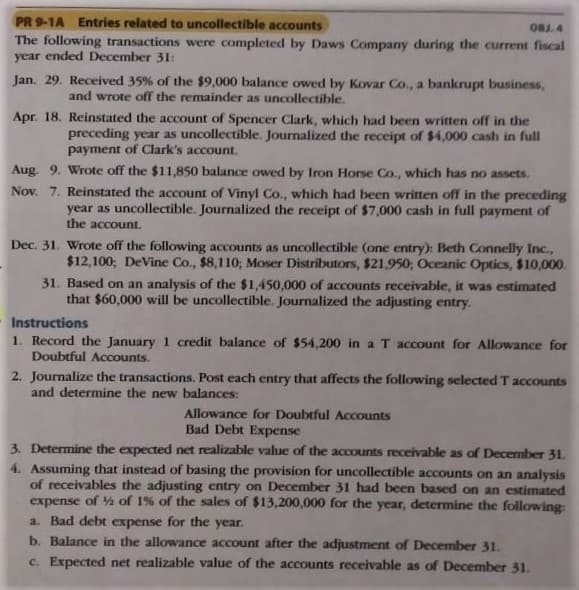PR 9-1A Entries related to uncollectible accounts OBJ. 4 The following transactions were completed by Daws Company during the current fiscal year ended December 31: Jan. 29. Received 35% of the $9,000 balance owed by Kovar Co., a bankrupt business, and wrote off the remainder as uncollectible. Apr. 18. Reinstated the account of Spencer Clark, which had been written off in the preceding year as uncollectible. Journalized the receipt of $4,000 cash in full payment of Clark's account. Aug. 9. Wrote off the $11,850 balance owed by Iron Horse Co., which has no assets. Nov. 7. Reinstated the account of Vinyl Co., which had been written off in the preceding year as uncollectible. Journalized the receipt of $7,000 cash in full payment of the account. Dec. 31. Wrote off the following accounts as uncollectible (one entry): Beth Connelly Inc., $12,100; DeVine Co., $8,110; Moser Distributors, $21,950; Oceanic Optics, $10,000. 31. Based on an analysis of the $1,450,000 of accounts receivable, it was estimated that $60,000 will be uncollectible. Journalized the adjusting entry. Instructions 1. Record the January 1 credit balance of $54,200 in a T account for Allowance for Doubtful Accounts. 2. Journalize the transactions. Post each entry that affects the following selected T accounts and determine the new balances: Allowance for Doubtful Accounts Bad Debt Expense 3. Determine the expected net realizable value of the accounts receivable as of December 31. 4. Assuming that instead of basing the provision for uncollectible accounts on an analysis of receivables the adjusting entry on December 31 had been based on an estimated expense of % of 1% of the sales of $13,200,000 for the year, determine the following a. Bad debt expense for the year. b. Balance in the allowance account after the adjustment of December 31. C. Expected net realizable value of the accounts receivable as of December 31.
The Effect Of Prepaid Taxes On Assets And Liabilities
Many businesses estimate tax liability and make payments throughout the year (often quarterly). When a company overestimates its tax liability, this results in the business paying a prepaid tax. Prepaid taxes will be reversed within one year but can result in prepaid assets and liabilities.
Final Accounts
Financial accounting is one of the branches of accounting in which the transactions arising in the business over a particular period are recorded.
Ledger Posting
A ledger is an account that provides information on all the transactions that have taken place during a particular period. It is also known as General Ledger. For example, your bank account statement is a general ledger that gives information about the amount paid/debited or received/ credited from your bank account over some time.
Trial Balance and Final Accounts
In accounting we start with recording transaction with journal entries then we make separate ledger account for each type of transaction. It is very necessary to check and verify that the transaction transferred to ledgers from the journal are accurately recorded or not. Trial balance helps in this. Trial balance helps to check the accuracy of posting the ledger accounts. It helps the accountant to assist in preparing final accounts. It also helps the accountant to check whether all the debits and credits of items are recorded and posted accurately. Like in a balance sheet debit and credit side should be equal, similarly in trial balance debit balance and credit balance should tally.
Adjustment Entries
At the end of every accounting period Adjustment Entries are made in order to adjust the accounts precisely replicate the expenses and revenue of the current period. It is also known as end of period adjustment. It can also be referred as financial reporting that corrects the errors made previously in the accounting period. The basic characteristics of every adjustment entry is that it affects at least one real account and one nominal account.
Is there any way possible you can explain the
Thank you so much :)

Trending now
This is a popular solution!
Step by step
Solved in 2 steps with 1 images







